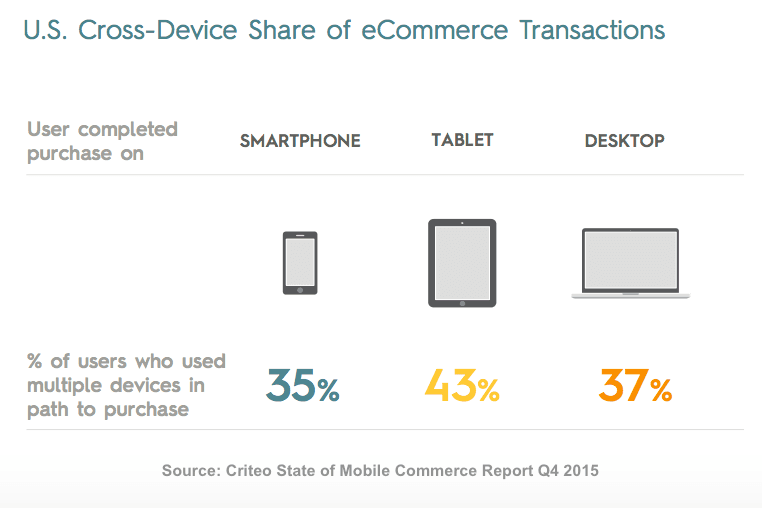3 Metrics for Understanding Mobile User Behavior
These metrics will get you thinking about what the future of mobile looks like.
As mobile technology becomes more sophisticated, consumers are using their phones in different ways. This rapid shift makes it hard to understand mobile user behavior. At the same time, for your mobile presence to succeed, you need to keep up with how people are using their devices. A major component of staying on top of these novel behaviors is adopting the right mobile analytics to help you better engage consumers.
This isn’t an extensive list of every new analytic, but it will give you an overview of the types of metrics to put in place, and get you thinking about what the future of mobile looks like.
1. Charting Cross-Platform Metrics
Users no longer rely on one device for interaction. Instead, they use several devices, sometimes simultaneously, to engage. A customer might browse your website on their laptop, follow you on Twitter from their phone, and purchase after seeing a discount code on their tablet’s Facebook app. If you don’t track this user’s behavior across all of these platforms, their engagement looks very different. Instead of having one customer whose journey takes them across multiple platforms, it will seem like you have separate customers coming in through different channels, only one of whom makes a purchase.
Cross-platform metrics, or matching a single user’s engagement to actions across multiple devices, are the current answer to the multiple device boom. In the example below, Criteo found that in Q4 of 2015, more than 35% of users purchasing on a phone, tablet, or computer used more than once device on their path to purchase.
Compare this to Q4 of 2014, when mobile only accounted for 27% of all eCommerce transactions in the US.

Stitching engagement together is tricky in part because of the different tracking and metrics that apply to each platform. What works on a website won’t necessarily work on an app, which means you need to be able to combine different tracking methods together for the full picture. Finding an efficient way to gather and sort this data is crucial, especially to improve your attribution modeling.
Amplitude allows you to keep different platforms all in one place, letting you realize your customers across platforms. This will give you an idea of what is and isn’t working for users, and strengthen your predictive metrics.
2. User Engagement and Scroll Depth
As users begin to spend less time on computers and complete more tasks on phones, it makes sense to look at what browser metrics could translate to mobile. For example, scroll depth could translate naturally to mobile analytics, because scrolling is the primary way of getting through content on a mobile device. Scroll depth is how far down on a page a user is going. This is a proxy for engagement that can help you judge how engaged a user is and where the best places for advertisements are.
It can also help you restructure your content to better engage users and highlight where users aren’t finding what they need. For example, if a user is scrolling all the way to the bottom of a search or an FAQ page, it could be an indication they aren’t getting the answer they’re looking for. If you support long-form readable content on an app or webpage (blog posts, news articles), scroll depth is clearly a productive way to measure engagement. Especially when as much as 51% of digital media consumption now happens on a mobile device. [Source: Smart Insights]

But even search-result or feed-based apps could use scroll depth to determine where the best places for advertisements are, or how their users are engaging. After all, there is a difference between a user who gets through an average of 15% of new posts on their feed and a user who gets through 80%.
While there isn’t currently huge support for scroll depth measuring on mobile, it’s clear that it could benefit apps and mobile browsing because of its impact on desktop. Whether or not scroll depth ends up being the next big mobile analytics trend, as our behaviors shift, understanding how the fundamental questions of laptop analytics can be applied to mobile phones is worthwhile.
3. Deeper Than Scroll Depth: Mobile Deep Linking
As we think about the ways in which analytic reasoning on desktops can be translated to mobile, deep linking becomes an interesting prospect on the mobile landscape. Deep linking is when a link opens a specific page in an app. Or, if the user doesn’t have the app, opens an app store to direct the user to the app download. It is akin to clicking on a saved link on your desktop and having your preferred browser open the exact webpage you saved.
As mobile continues to be used for more complex behaviors, looking at connections between your app and links will become more important. If you send an email with a link and your customer opens it on their phone, you want them to get straight to the content, which means deep links. We can see in the graph from TechCrunch below that landing on a specific page in-app makes on average about an 8% difference in active users on Day 1 since install. Even four days after install, deep links continue to pay off in higher active user rates.
[Source: TechCrunch]

If you’re linking, you want to be tracking and analyzing customer behavior. Looking at where your customers are coming from, where they’re landing in your app, and how engaged they are where they land are important steps in solidifying your overall mobile strategy, because they tell you what customer paths work. It is possible that mobile deep linking will become a compelling way to chart mobile paths across platforms and apps, like the internet. It could also see expanded integration in marketing. For example, if a brand ambassador could post on an app like Instagram with a link straight to a page in your app, that could be a driver of mobile strategy.
Brand ambassadors have become ubiquitous, so using deep links to mine their mobile influence will maximize their potential impact. Although an easily accessible web of mobile deep links doesn’t exist yet, projecting the future of mobile means thinking about how we engage with mobile content in the most efficient ways. If you’re interested in what you can do with mobile deep links right now, we have deep linking tools in conjunction with Branch so you can properly understand and evaluate your links and marketing channels.
The Future of Mobile
Paying attention to mobile is critical if you want to stay on the cutting edge of consumer behaviors. Because mobile’s true potential is still being uncovered, mobile analytics keep pushing towards better models to understand how and why people are using their phones. Discovering new ways to map user engagement is one of the most exciting parts of diving into mobile analytics. The future only has more mobile to offer.
With 5G on the horizon, and everyone jumping on the mobile VR bandwagon, mobile analytics has just begun. From tracking eye movements in VR to more sophisticated device pairings, mobile analytics is only going to become more crucial for those truly invested in uncovering user patterns of behavior.

Archana Madhavan
Senior Learning Experience Designer, Amplitude
Archana is a Senior Learning Experience Designer on the Customer Education team at Amplitude. She develops educational content and courses to help Amplitude users better analyze their customer data to build better products.
More from Archana




